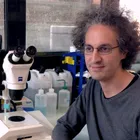Presentation

The last decade has seen the emergence of new genome modification technologies. Published in 2012, the CRISPR/Cas9 system, that granted Emmanuelle Charpentier and Jennifer Doudna with Chemistry Nobel Prize in 2020, allows by its great flexibility, the individual inactivation of all known genes by targeted cutting of the DNA.
Created in September 2017, the CRISPR’it core facility takes advantage of the CRISPR technology to perform lentiviral-based genetic screens in cell lines.
Genetic screens are powerful tools that enable the genome-wide interrogation of gene function through CRISPR-based mutagenesis or transcriptional modulation either by CRISPRi (inhibition) or CRISPRa (activation).
(SCREEN overview figure to come)
Because each project is unique, the CRISPR’it platform advises scientists in their screening projects and oversees the whole screening procedure from library preparation to bio-informatic analysis :
1- Library preparation (genome-wide or custom)
2- Virus production and titration
3- Infection of target cells and NGS library preparation
4- NGS by Curie Sequencing platform
5- Bio-informatic analysis
Collaborations
The CRISPR'it platform works in close collaboration with the NGS platform and Bio-informatics platform of Curie Institute throughout the entire screen process to identify candidate genes.














 Paris [Conférence-discussion ] - 24 septembre 2024
Paris [Conférence-discussion ] - 24 septembre 2024 Marseille [Conférence-discussion ] - 26 septembre 2022
Marseille [Conférence-discussion ] - 26 septembre 2022
